
Ten Edible Succulents and How to Prepare Them
These ten edible succulents can go from garden to kitchen. Most are fairly easy to obtain, cultivate and prepare. The mucilaginous (goopy) texture of certain edible succulents makes them---to spin it positively---great in soups and stews. Vitamin C is one reason for their sour taste; another is the plants' sophisticated "crassulacean acid metabolism" (CAM). This peaks in early morning, so wait until later in the day to harvest.
Update: After Farmer Fred saw this post, he had me on his radio show. We had a great time discussing edible succulents. Listen to the podcast.
Ten Edible Succulents and How to Prepare Them
I've listed these in order of personal preference. Those that are more difficult to find or cultivate, are less palatable, or that I've yet to try, are farther down the list. And because I couldn't resist (it's just so interesting!) I've included an edible succulent that'll get you high. Why haven't I included aloe vera and tequila agave? Simply because they need processing.
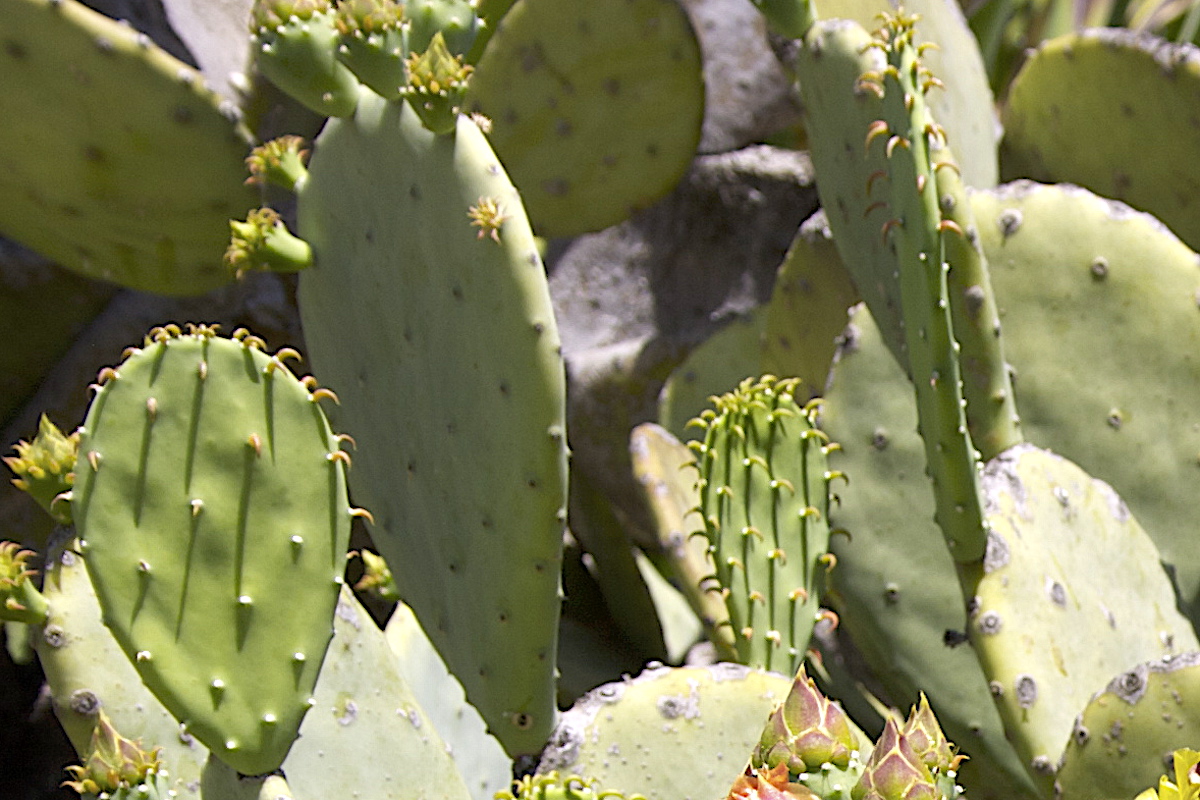
Young, bright green pads are best. Older ones can be woody.
Opuntia cactus (paddle cactus)
Eat tender, thumb-sized new pads raw and in salads. For the Mexican dish nopales, use young pads about four to eight inches long. Opuntia ficus-indica is the species most often sold in markets. Scrape off spines and cut into bite-sized pieces. Boil or roast until tender. Use as a side dish or add to salsa and tacos. Dislike the goop? Grill the pads. Score in a cross-hatch so the goo oozes out and evaporates. Gosh they're good!
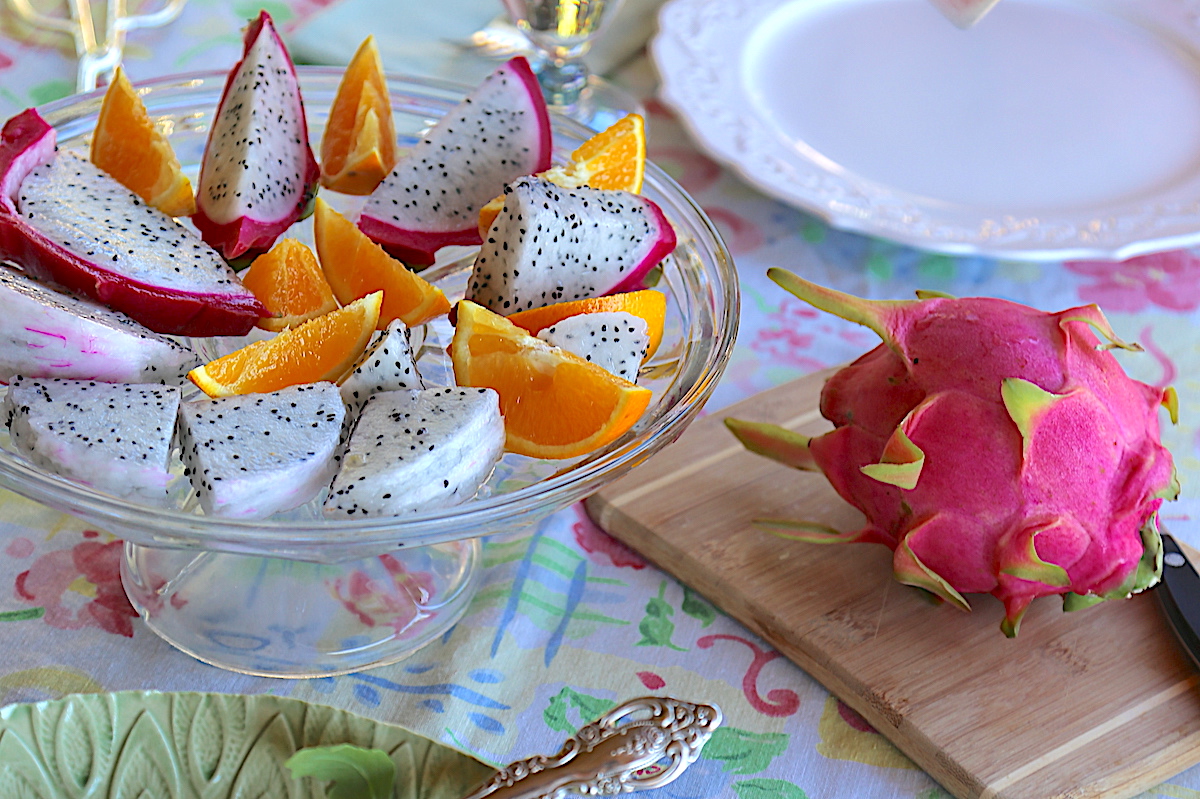
Dragon fruit makes a lovely addition to a fruit plate.
Dragon fruit
Although the fruit of many cacti are edible, you have to contend with spines and abundant small seeds. Those easiest to harvest and prepare are dragon fruit (pitaya, in the genus Hylocereus). I do grow it in my inland Southern CA garden, but clearly it prefers its native habitats of Central and South America. The climbing vine needs sun to thrive, bloom and set fruit, but (here) if not shaded, it burns. Dragon fruit, sold at farm stands in the fall, is beautiful but bland. Tiny black seeds make the flesh crunchy. Peel, slice, and eat raw or juiced. There exist dozens of cultivars.

Elephant's food is sour and crunchy.
Portulacaria afra (elephant's food)
I wouldn't be without this versatile landscape succulent. It's native to South Africa (where it's the primary diet of elephants). It grows effortlessly here in California, yet also thrives in desert and tropical climates. See how I use elephant's food as a garnish in this video. Learn more about this remarkable succulent.
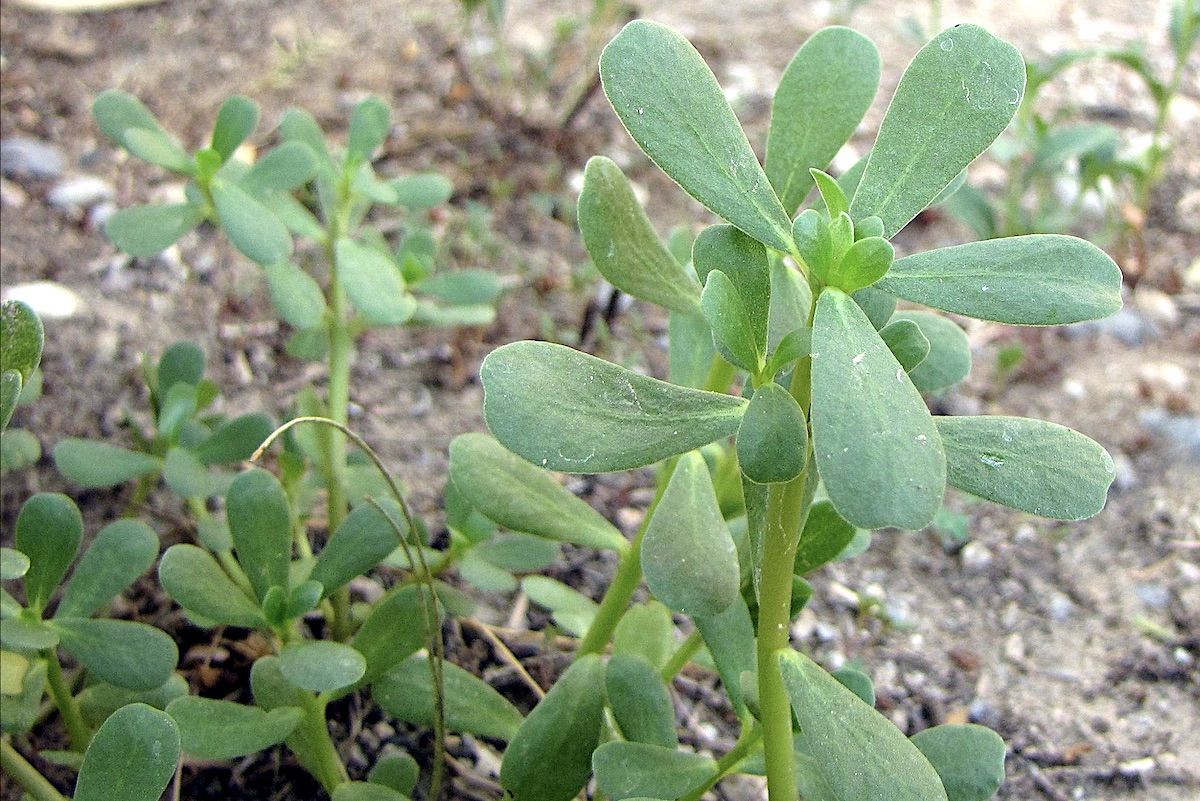
Purslane is a weed worth having.
Purslane
Purslane (Portulaca oleracea) is both a vegetable and an annual weed. The taste is similar to watercress, so use it as you might spinach or lettuce. It's loaded with vitamins, minerals and antioxidants, and is higher in omega-3 fatty acids than other greens. I occasionally run across it when weeding my garden, so do watch for it in yours. Or start it from seed. Use it as an ornamental filler for succulent container gardens, hanging pots and window boxes.

The challenge with yucca flowers is not how to prepare them, but how to get to them.
Yucca flowers
Please don't confuse yucca with botanically unrelated "yuca" (cassava root). Yucca roots are not edible. (I occasionally see the two confused in markets and on menus. Makes me crazy.) Harvest blooms while yet in bud, because open flowers are bitter. Remove pistils and steam or sauté petals until tender. Add to egg dishes, casseroles and meat stews. Or as they do in Yucatan, make yucca-petal tamales.
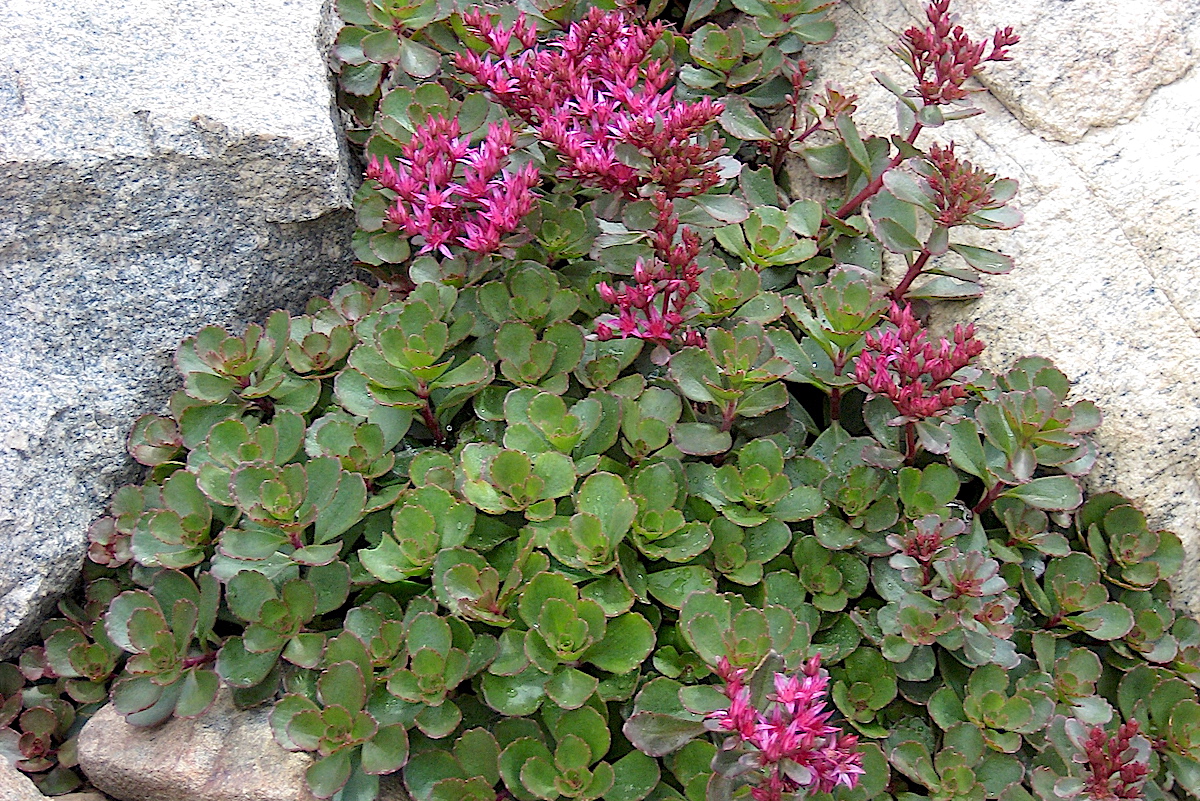
You're more likely to find edible sedums in cold climates.
Red-flowering sedums
The peppery leaves, stems and roots of fine-leaved stonecrops (as opposed to fat-leaved sedums) add flavor to stir-frys. Cooking moderates bitterness. Large amounts can upset the stomach. Use only red-flowering varieties in salads; those with yellow flowers are mildly toxic when raw.

With its pink and orange tips and powdery blue leaves, Dudleya edulis is too pretty to eat.
Dudleya edulis
The common name, chalk lettuce, is a hint. This California native has upright, grayish, powdery leaves shaped sort of like green beans. It needs to be cooked to be palatable.

It's easier to forage Salicornia than grow it.
Salicornia
Salicornia europaea (sea beans, sea asparagus, marsh samphire), an annual succulent found on the edges of salt marshes, is tasty cooked or raw. It's gaining popularity among chefs as a garnish because of its salty, crispy crunch (blanch first). The plant is common in the wild but challenging to cultivate. If you want to try, grow it in sandy soil and when watering, add 1 tsp. sea salt per pint.
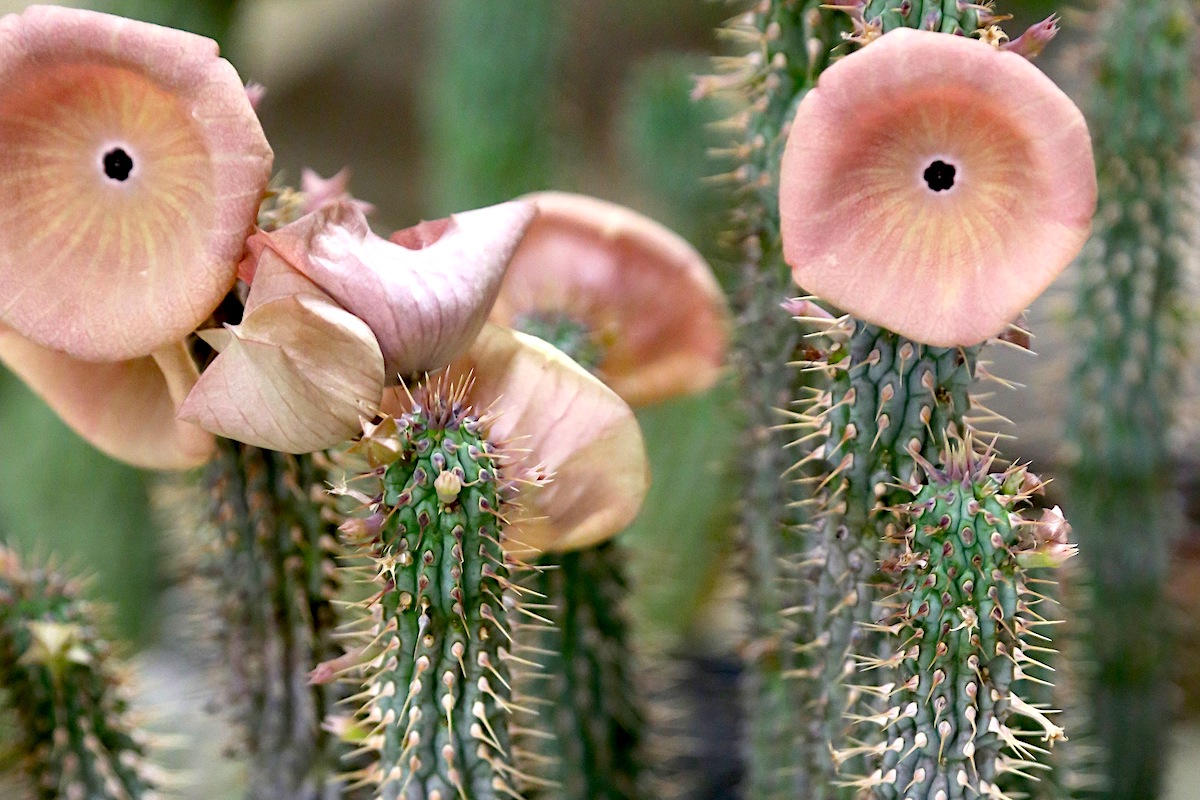
I'm not aware that Hoodia gordonii flowers are edible, but I just had to show you them.
Hoodia gordonii
This stapeliad is used by indigenous peoples of South Africa to assuage hunger pangs during Kalahari hunting trips...hence its renown as an appetite suppressant here in the Land of the Overfed. Slice off the spikes and consume raw. The taste and texture are reminiscent of cucumber.

These are peyote "buttons."
Peyote
You didn't hear it from me, but impressive specimens of this muffin-sized cactus often are on display at Cactus and Succulent Society shows, labeled merely Lophocereus williamsii---an inside joke that generates grins and elbow nudges. Because it's a source of the hallucinogenic drug mescaline, peyote is illegal to possess and ingest except for members of the Native American Church. It's an emetic; vomiting is not uncommon during religious rituals. Sadly, peyote is endangered in its native Texas due to over-harvesting.
Note: This article is for educational purposes only. I am neither a culinary professional nor a medical herbalist. I take no responsibility for any allergies, stomach upset or other concerns that might result from cultivating or ingesting plants mentioned. -- Debra Lee Baldwin
Related Info on This Site
Why You Should Grow Aloe Vera
Can you grow Aloe vera in your garden as an ornamental plant and harvest its medicinal leaves? Yes, but heed cautions below. This midsized succulent with tall, slender yellow flowers is famous for gel that soothes minor burns and skin irritations.
Portulacaria afra (Elephant Bush): Photos, Varieties, Cultivation, Uses
Portulacaria afra: Uses, Photos and Varieties Native to South Africa, elephant bush thrives outdoors in warm, sunny climates such as CA, Arizona, Florida and Hawaii See All Succulent Types Aeonium Agaves Aloes Cactus Crassula Echeveria Euphorbias Ice Plants Kalanchoe Portulacaria Senecio About Portulacaria afra Portulacaria afra (elephant’s food, elephant bush, spekboom) thrives in warm, sunny climates.…
Cactus: Details, Photos and Varieties
Cactus Care, Gallery and Names All cacti are succulents, but not all succulents are cacti. They’re not for everyone, but once hooked (forgive the pun) you’ll collect more and more. See All Succulent Types Aeonium Agaves Aloes Cactus Crassula Echeveria Euphorbias Ice Plants Kalanchoe Portulacaria Senecio About Cacti Native to deserts and dry regions of…




Thank you, that was so informative. We tend not to think such plants can also be used as garnish. I did not see where your Video is located..Thanks, Birte
Hi Birte — Oops, I forgot to add the link. Many thanks for calling it to my attention! Debra
How to Make an Elephant’s Food Salad (YouTube)
Interesting about succulents we can eat. Never felt compelled to try any, though.
As for edible succulents, I’ve recently discovered Plectranthus amboinicus or Cuban oregano. It’s a sweet looking plant which doesn’t mind some shade. I’ve read it is edible but have not tried it myself. Honestly the smell is not that appealing.
I’ve grown that! It’s a curiosity—one of those plants that keep children engaged in the garden, because of its strong smell comparable to Vicks or turpentine. I didn’t know it was edible, but it IS in the mint family, so that makes sense. Btw, I googled it, and in Cuba’s it’s called “French oregano” and isn’t native to Cuba at all, but rather India, Southeast Asia and the Middle East. Although it has cultivation requirements similar to succulents, it’s more of a companion plant, and is a “semi-succulent” perennial. I’ve understand you can rub the leaves on your skin to repel insects, but I’ve never tried it. Not sure I’d want to!
I included portulacaria afra in my salad not so bad it’s a little bit sour and my mexican friend always makes the paddle cactus like a salad she said its good for diabetes. I like the dragon fruit I always bought it in asian grocery and my sister inlaw she got some at her Backyard! Nice to get some information About other cacti Debra.
Thanks for information I grow and love Succulent plant my sheep love it. But I am in Australia and I have to hide it, from Australian Aboriginal decent people in Council authority, Australian Authorities declared all non Aboriginal Plant as noxious weeds, that includes Oliver Trees. And Non Aboriginal Australian Citizens as second class Citizens. If you google. Australian first nation. You will get most of information.
Thanks for the information on edible succulents, I’ve lots of potulacaria in my garden and will definitely try now. From India
Yep, I can believe it grows in India. Thanks, Varuna!
What about Peruvian Apple,cactus
Yes, that’s a wonderful one! Thanks for the reminder.